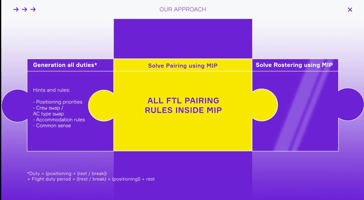People usually think that optimization is the very problem for quantum computers to solve. Once, we...
Understanding the Difference between Suboptimal and Global Optimal
🌟 Understanding the Difference between Suboptimal and Global Optimal Solutions in Flight Crew Optimization 🌟
Have you ever wondered how airlines optimize their flight crew assignments to ensure efficient operations? 🛫 Let's explore the concept of suboptimal and global optimal solutions in the context of flight crew optimization, challenging the common notion that the global optimum always holds greater value.
In flight crew optimization, suboptimal solutions refer to crew assignments that may not be the absolute best possible configuration but still meet operational requirements. These assignments could be locally optimal, considering factors like crew availability, flight schedules, and regulatory constraints within a specific region or timeframe. Suboptimal solutions are valuable in their ability to provide feasible crew configurations, ensuring the smooth functioning of airline operations.
On the other hand, the global optimum in flight crew optimization represents the absolute best crew assignment across all flights, routes, and time periods. It maximizes efficiency, minimizes costs, and satisfies all operational criteria simultaneously. However, achieving the global optimum is an intricate task due to the complexity of airline networks, crew preferences, and dynamic scheduling requirements.
Contrary to popular belief, the global optimum doesn't always hold more value compared to suboptimal solutions in flight crew optimization. Here's why:
1️⃣ Practical Considerations: Airlines face numerous operational challenges, such as crew availability, flight disruptions, and last-minute schedule changes. Striving for the global optimum may require significant time and computational resources, which might not be feasible within the constraints of real-world operations. Therefore, suboptimal crew assignments that meet operational needs efficiently and promptly hold substantial value.
2️⃣ Trade-offs: Flight crew optimization involves various factors, including crew preferences, rest periods, flight regulations, and costs. Striving for the global optimum may prioritize one objective, such as cost minimization, but neglect other important aspects, such as crew satisfaction or customer service. Suboptimal solutions that strike a balance between these competing objectives can offer a more favorable outcome.
3️⃣ Uncertainty and Dynamic Environments: The aviation industry operates in a dynamic environment, subject to unpredictable events like weather disruptions or airspace restrictions. Pursuing the global optimum assumes a static operational environment, which doesn't reflect the reality of the industry. Adapting to changes and finding robust suboptimal solutions that can handle unexpected events efficiently may be more valuable in such circumstances.
When optimizing flight crew assignments, it's crucial to consider the trade-offs, operational constraints, and dynamic nature of the airline industry. Embracing suboptimal solutions that provide feasible crew configurations and address specific operational requirements can lead to significant improvements in efficiency, crew satisfaction, and overall customer experience.
Next time you board a flight, appreciate the intricacies involved in optimizing the flight crew assignments. Remember that achieving the global optimum may not always be practical or desirable, and suboptimal solutions can deliver remarkable results while maintaining operational effectiveness.
#FlightCrewOptimization #SuboptimalSolutions #GlobalOptimum #Efficiency #Tradeoffs #AirlineOperations #DynamicEnvironment


